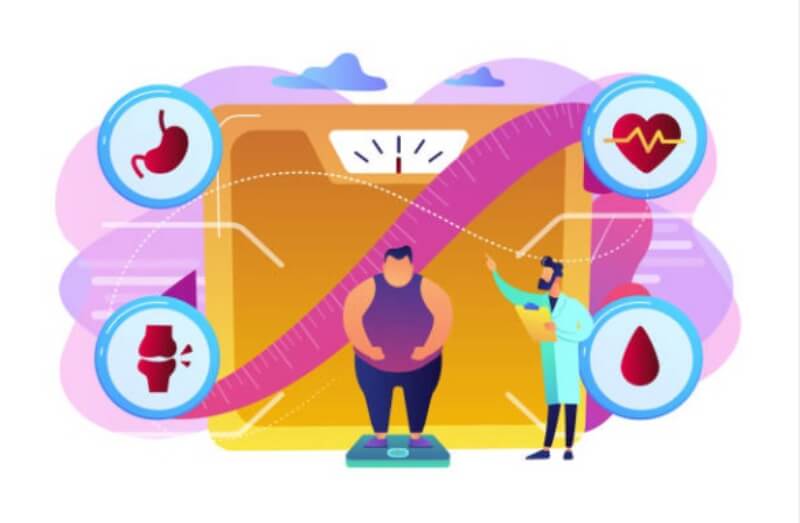
Nobody likes having excess belly fat, or the so-called ‘office belt’. One of the most widespread problems among people today is being overweight and obese. In most cases, this is the result of daily consumption of unhealthy food (salt and sugar, or fats and carbs), lack of exercise and quality sleep, and high-stress levels. To put it in simpler words, if you tend to overeat, don’t be surprised when the excess kilos and pounds pilling up. This premise leads to an imbalance between the calorie count acquired and spent by the body. As well as its energy input and output.
Depending on the degree to which this condition has advanced, the body begins to accumulate excess kilos, which, in its essence, is the process of becoming obese or overweight. The modern-day market offers a multitude of different all-natural and completely-reliable tools. Such as the Kanabialica body-shaping drops.
You can track how if you are living healthy enough, using the body mass index (BMI – Body Mass Index). With its help, people easily determine whether one is under or overweight. Statistically, it is considered that people whose BMI is above 25 kg/m2 are prone to cardiovascular health issues. This refers to the maximum possible level of people, suffering from obesity (BMI> 30kg/m2).
Which are the main hazards to one’s well-being if you are obese? How to tackle the excess kilos and pounds without going on risky diets? Are there any ways to get back in shape without going on a tiresome and risky diet? Which are the best ways to avoid being overweight?
Learn the answer to all these questions by reading the full article on the subject below!
What Is Obesity & How to Avoid Becoming Overweight

The World Health Organization (WHO) has underlined the perils that obesity presents to one’s bodily well-being many times. It issued a special report back in 2000, entitled ‘Obesity: Preventing & Managing the Global Epidemic’. The said identifies the presence of too much excess belly fat as:
abnormal or excessive fat accumulation that presents a risk to health
Obesity (‘obesitas’ in Latin) and overweight are the two terms used to describe the range of weight gain above the levels that are considered healthy. The average BMI for a person is measured, taking into consideration one’s height, age, and gender. They are also used to set certain dietary and lifestyle limits that have been shown to increase the likelihood of certain diseases. Most of them are socially significant, like type 2 diabetes, cardiovascular, vascular, and cerebrovascular diseases.
Obesity and overweight are often defined, using the following criterion:
- A chronic condition, associated with the accumulation of excessive amounts of body fat.
- This can happen subcutaneously, in the abdominal cavity, or around the internal organs.
- It harms health and is associated not only with various serious medical ailments but also with reduced life expectancy.
- Often the term obesity is incorrectly understood, as an increase in total body mass. But the said is formed both by the amount of adipose tissue and the total mass of bone and muscle tissue. To them are also added the weight of internal organs and the amount of water and fluids, present in the body.
- In obesity, there is an increase in the total body mass but at the expense of the adipose tissue.
- Although similar to ‘obesity’, the term “overweight” is used to denote a bigger body mass for the corresponding height.
Which Are the Main Risks of Being Obese & Overweight

Cardiovascular problems are often associated with excess weight and it is not without reason. Studies and medical analyzes found that many health problems, such as diabetes mellitus, metabolic syndrome, dyslipidemia, hypertension, and atherosclerosis are its consequence. Furthermore, heart diseases in combination with osteoporosis and gastroesophageal reflux are also triggered by being overweight and obese.
The metabolic syndrome (still known as Syndrome X) causes hypertension, increased blood sugar, and an imbalance between low-density lipoproteins and triglycerides. In simpler words, it is accepted that waist circumference greater than 102 cm for men and 88 cm for women is considered a high-risk factor. It causes cardiovascular diseases that are a direct consequence of the metabolic syndrome.
Being overweight is dangerous to one’s health and the number of people, suffering from obesity, grows rapidly and steadily. This is disturbing. Therefore, it is important to study the most widespread causes of this condition. As a result, it is necessary to adopt measures that help limit the amount of excess belly fat. It is also important for people to stay well-informed. They should also be made aware of good methods of preventing and fighting obesity. So that they will be able to undertake the right measures on their own and protect themselves.
How to Avoid Obesity?

The best way to treat obesity is to eat healthily and exercise regularly. By eating three meals a day with two snacks in between, you can limit the amount of fat, accumulated by the body. Eat more fruits and vegetables and stop drinking drinks with high sugar content. Regular exercises and physical activity will help you get in shape the right way. Training can be a fun activity. Be creative. Do it with friends. Combining an active lifestyle with a healthy and balanced meal plan will improve the quality of your life.
Here are some quick tips for staying fit & slim:
- Eat moderately but regularly. Organize the food intake into 3 main meals with 2-3 snacks and reduce the size and rationing of the portions.
- Observe certain food consumption rituals. Have dinner no later than 2-3 hours before bedtime;
- Up the intake of fruits and vegetables. Consume legumes and organic wheat cereals regularly. These products are low in fat and rich in dietary fiber. They give energy and vitality while enhancing the feeling of satiety.
- Avoid spicy seasonings, sugar, and salt. They can make your body retain more liquids and increase the average BMI. Also, it is harder for the organism to transform them into carbs.
- Drink at least 1.5 l. of water and fluids daily. This will refresh and tone your body.
- Reduce the consumption of fats and alcohol. Such beverages are full of unhealthy calories and carbs.
- Limit the consumption of confectionery and pasta (pastes, cakes, chocolate desserts, pies, etc.). In addition to carbohydrates, they are also of fats that usually get stored as fatty cell deposits and not utilized as energy.
- Exercise daily. It will help you boost your metabolism.
Lead a Balanced & Beautiful Life to Avoid Being Obese

Maintaining a good BMI will help you be fit and stay healthy. Having minimum amounts of belly fat will also help you think higher of yourself and improve your self-esteem. Not to mention that it will also make you more appealing to others. The advancements in modern science have allowed for many truly reliable body-shaping tools with organic composition. A good and properly-working suggestion is the NexaSlim. Remember, your body, mind, and soul’s well-being is entirely in your hands. As well as the quality of life you lead. Don’t make second-hand choices.
- D-Fit Reviews | Burn Visceral Fats & Shape the Silhouette - 26/08/2024
- Restilen – Does It Work? Reviews and Price? - 14/08/2024
- Prostasit Reviews | Boost Potency & Improve Love-Making - 09/08/2024




